
The Mercedes D.III, or F1466 as it was known internally, was a six-cylinder SOHC valvetrain liquid-cooled inline aircraft engine built by Daimler and used on a wide variety of German aircraft during World War I. The initial versions were introduced in 1914 at 120 kW (160 hp), but a series of changes improved this to 130 kW (170 hp) in 1917, and 130 kW (180 hp) by mid-1918. These later models were used on almost all late-war German fighters, and its only real competition, the BMW III, was available only in very limited numbers. Compared to the Allied engines it faced, the D.III was generally outdated.

The Mercedes D.II was a six-cylinder, SOHC valvetrain liquid-cooled inline aircraft engine built by Daimler during the early stages of World War I. Producing about 110 to 120 hp, it was at the low-end of the power range of contemporary engines, and was generally outperformed by rotaries whose power-to-weight ratio tended to be much better. It also had stiff competition from the Ferdinand Porsche-designed 120 hp Austro-Daimler 6. The D.II was produced only briefly as a result, but its design formed the basis for the later Mercedes D.III which saw widespread use throughout the war.
The Mercedes D.I was a six-cylinder, water-cooled, SOHC valvetrain inline engine developed in Germany for use in aircraft in 1913. Developing 75 kW (100 hp), it powered many German military aircraft during the very early part of World War I.
The Benz Bz.III was a six-cylinder, water-cooled, inline engine developed in Germany for use in aircraft in 1914. Developing 112 kW (150 hp) at 1,400 rpm from 14.3 L, it powered many German military aircraft during World War I. It was replaced in production by the unrelated Benz Bz.IIIa. and eventually the V-8 Benz Bz.IIIb. The Benz Bz.III was built under licence in Sweden by AB Thulinverken, known as the Thulin E.

The Mercedes D.IVa was a German six-cylinder, water-cooled, inline engine developed in 1917 for use in aircraft and built by Daimler Motoren Gesellschaft (DMG).

The Walter Minor is a family of four- and six-cylinder inverted inline air-cooled engines, developed under auspices of ing. Šimůnek and used on light aircraft. First produced in 1929, the Minor engines' family has an advanced design for the period and sports steel cylinders, aluminum heads and overhead valves, with identical bore and stroke of 105 mm (4.1 in) and 115 mm (4.5 in), respectively. Typical power ratings varied from 105 to 160 hp.
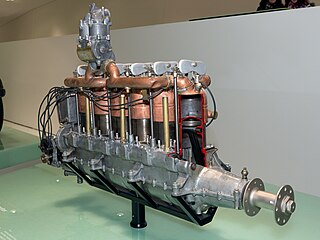
The Austro-Daimler 6 was a series of Austrian six-cylinder water-cooled inline aero engines first produced in 1910 by the Austro-Daimler company.
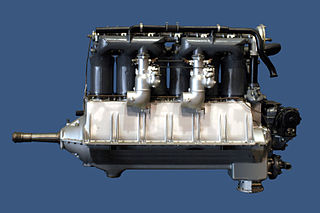
The Liberty L-6 was a six-cylinder water-cooled inline aircraft engine developed in the United States during World War I.

The Hansa-Brandenburg C.I, also known as Type LDD, was a 2-seater armed single-engine reconnaissance biplane designed by Ernst Heinkel, who worked at that time for the parent company in Germany. The C.I had similarities with the earlier B.I, including inward-sloping interplane bracing struts. Like other early-war Austro-Hungarian reconnaissance aircraft, such as C-types of Lloyd or Lohner, the Type LDD had a communal cockpit for its crew.
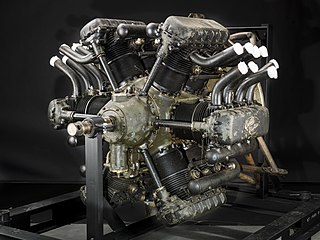
The Curtiss H-1640 Chieftain was an unusual American 12-cylinder radial aero engine designed and built by the Curtiss Aeroplane and Motor Company in the mid-1920s. In contrast to most multi-row radials, where the cylinders in the rows are staggered to present better airflow for cooling, the Chieftain used the inline radial arrangement with the cylinders behind each other to allow pairs of cylinders to share a cast cylinder head and camshafts. The design saw some use in the 1920s but was quickly passed by newer designs.

The Beardmore 120 hp was a British six-cylinder, water-cooled aero engine that first ran in 1914, it was built by William Beardmore and Company as a licensed-built version of the Austro-Daimler 6. The engine featured cast iron cylinders and mild steel concave pistons. Produced between August 1914 and December 1918, the design powered many World War I aircraft types.
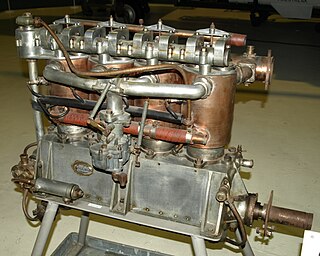
The Green C.4 was a British four-cylinder, water-cooled aero engine that first ran in 1908, it was designed by Gustavus Green and licensed by his Green Engine Co for manufacture by Aster Engineering. The engine was one of two Green designs to win a government prize.

The Beardmore 160 hp is a British six-cylinder, water-cooled aero engine that first ran in 1916. It was built by Arrol-Johnston and Crossley Motors for William Beardmore and Company as a development of the Beardmore 120 hp, itself a licensed-built version of the Austro-Daimler 6.

The Green E.6 was a British six-cylinder, water-cooled aero engine that first ran in 1911, it was designed by Gustavus Green and built by the Green Engine Co and Mirlees, Bickerton & Day of Stockport between August 1914 and December 1918.
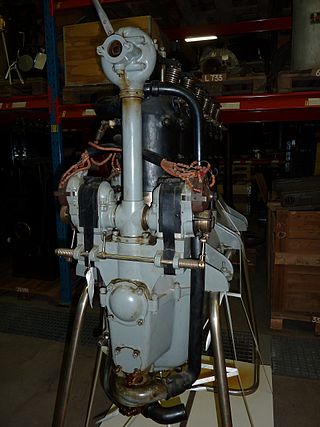
The Junkers L2 was Junkers' first water-cooled four-stroke engine and the first to be built on a production line, though only 58 were made. It was a six-cylinder inline engine and powered many Junkers aircraft until replaced by the more powerful L5.

The Phönix C.I, given serial numbers in the Phönix 121 range, was an Austro-Hungarian First World War reconnaissance and general-purpose Biplane built by Phönix and Lloyd.
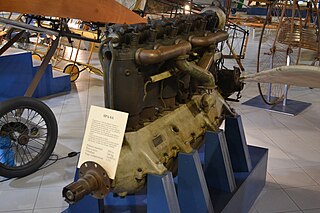
The SPA 6A is an Italian water-cooled inline six-cylinder aero engine of the World War I era. The SPA 6A is mostly known for its use in the Ansaldo SVA high speed reconnaissance aircraft.
The Isotta Fraschini V.5 of 1916 was an Italian eight-cylinder, water-cooled, in-line piston aero engine of World War I. The "V" denoted "Volo" or "flight" rather than piston arrangement.
The Oeffag G , sometimes known as the Oeffag Type G or Oeffag-Mickl G, was a three-engined reconnaissance flying boat built in Austria during the First World War and deployed by the Kaiserlich und Königlich Seefliegerkorps.

The Galloway Adriatic was a WW1 era inline-six aircraft engine. In British military service the engine was known as the 230 hp BHP, a designation it shared with a version of the same engine built by Siddeley-Deasy. Although the Galloway and Siddeley-Deasy versions followed a similar design, they had different dimensions and few interchangeable parts. Siddeley-Deasy developed their version of the 230 hp BHP as the Siddeley Puma.
















